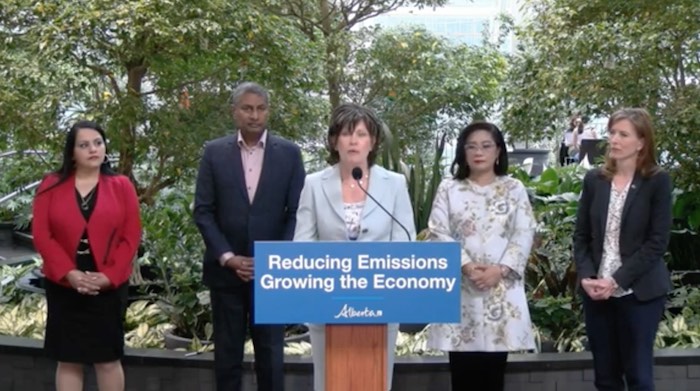Alberta
Province will balance the economy and the environment – Emissions Reduction and Energy Development Plan

Balancing the economy and the environment
Alberta’s new Emissions Reduction and Energy Development (ERED) Plan charts Alberta’s course for cutting emissions, attracting investment and growing the economy.
Albertans have been stewards of one of Canada’s largest economic engines, the oil and gas sector. For decades, Albertans have stepped up to deliver responsible, ethically produced energy, helping mitigate global energy crises and leading in technology innovation to reduce emissions.
The ERED Plan is Alberta’s path forward to net-zero aspirations by 2050 while maintaining affordable, reliable and secure energy for Albertans. The plan affirms that responsibly produced oil and gas will continue to be a fundamental part of the global energy mix in the coming decades while sending a clear signal to the world that Alberta is the place to invest.
“Our made-in-Alberta plan to reduce emissions while growing the economy is a plan that works for Albertans. This could never be a one-size-fits-all model passed on by the federal government. I’m so proud of the work that has been done to bring this forward. Alberta can, and will, be a part of the solution to safeguard North American and global energy security. We can make real progress on environmental protection without sacrificing Alberta’s and Canada’s economic engine.”
Cutting emissions should not make life harder and more expensive. Actions in the ERED Plan like modernizing the electricity system, integrating new technology and supporting natural gas-fired generation will help keep energy reliable, safe and affordable for Albertans.
In February, Premier Danielle Smith sent a letter to Prime Minister Justin Trudeau, informing the federal government that a made-in-Alberta plan was on the way. Alberta’s government is calling on the federal government to stop setting unrealistic, unachievable targets, to stay in their lane and work with the provinces without interfering in provincial jurisdiction. Families need to keep the lights on, buy groceries and have enough gas in their car to get their kids to soccer practice without carrying the burden of expensive government climate policies.
Former premier Ralph Klein took the first step by putting out the first such plan in 1998. Since then, decades of hard work from the men and women who make their living in Alberta’s industries have led to today. The plan Alberta’s government is unveiling salutes the work done by Albertans over decades, culminating in a significant focus over the last four years, and charts the province’s next steps. More work is yet to be done.
“Alberta’s plan forward to reduce emissions while growing economic activity sets a course of success for our province. The conversation about emissions reduction must include energy security, affordability and reliability. This plan does exactly that.”
Alberta’s ERED Plan outlines investment and partnership opportunities, including ways to better support Alberta’s skilled workforce, strengthen relationships with Indigenous organizations and communities, and collaborate with industry. By driving emissions reductions in all sectors through clean technology and innovative solutions, Alberta’s plan protects and diversifies jobs and keeps money in the pockets of hard-working Albertans.
“Alberta will make an outsized contribution to Canada and the rest of the world by developing low-cost technologies towards successful decarbonization. Given Alberta’s ingenuity and energy expertise, it is in the best position to support Canada’s aim to achieve net-zero emissions in 2050.”
“Alberta has demonstrated tremendous leadership in economic reconciliation for Indigenous Peoples by creating opportunities for Indigenous communities to participate in projects that will drive tangible economic benefits and prosperity for generations to come.”
The ERED Plan outlines actions and opportunities across Alberta’s environment and economy, from oil and gas to agriculture and waste management. A summary of actions is available on the ERED Plan website.
As part of Alberta’s work to address the rising cost of living due to inflation, the ERED Plan includes a commitment to explore building codes, labelling and building benchmarking, balancing informed consumer choice with property right considerations, and exploring and growing innovation and technology for homes like new building materials and heat pumps.
“The Pathways Alliance is encouraged by the Government of Alberta’s plan to reduce emissions and achieve net zero while ensuring industry can compete globally, attract investment and continue to provide economic growth and prosperity for Albertans and Canadians.”
“Alberta’s Emissions Reduction and Energy Development Plan presents evidence that Alberta does not require overlapping federal regulation to do what is necessary to meet net zero by 2050 goals. The plan’s net zero by 2050 aspiration is the statement that investors and analysts have been looking for as the overarching signal of commitment to emissions reductions action.”
Quick facts
- Alberta was the first jurisdiction in Canada to establish a climate plan in 1998.
- Alberta was the first jurisdiction in North America to introduce an industrial carbon price and emissions trading system in 2007.
- Alberta was the first government in Canada to set a methane emissions reduction target for the oil and gas sector and is on track to meet and exceed its 2025 methane emissions reduction goal.
- Alberta is expected to transition from coal-fired electricity in 2023, seven years ahead of provincial and federal targets.
- The Technology Innovation and Emissions Reduction (TIER) Regulation, Alberta’s industrial carbon pricing system, is at the core of emissions management in Alberta.
- From 2009 to 2021, $2.5 billion from industrial carbon pricing funds were invested in programs that support emissions reductions and climate resiliency.
- Alberta is recognized as a leader in developing carbon capture, utilization and storage (CCUS) technology, committing more than $1.8 billion to support CCUS projects to date.
Alberta
Red Deer Justice Centre Grand Opening: Building access to justice for Albertans

The new Red Deer Justice Centre will help Albertans resolve their legal matters faster.
Albertans deserve to have access to a fair, accessible and transparent justice system. Modernizing Alberta’s courthouse infrastructure will help make sure Alberta’s justice system runs efficiently and meets the needs of the province’s growing population.
Alberta’s government has invested $191 million to build the new Red Deer Justice Centre, increasing the number of courtrooms from eight to 12, allowing more cases to be heard at one time.
“Modern, accessible courthouses and streamlined services not only strengthen our justice
system – they build safer, stronger communities across the province. Investing in the new Red Deer Justice Centre is vital to helping our justice system operate more efficiently, and will give people in Red Deer and across central Alberta better access to justice.”

Government of Alberta and Judiciary representatives with special guests at the Red Deer Justice Centre plaque unveiling event April 22, 2025.
On March 3, all court services in Red Deer began operating out of the new justice centre. The new justice centre has 12 courtrooms fully built and equipped with video-conference equipment to allow witnesses to attend remotely if they cannot travel, and vulnerable witnesses to testify from outside the courtroom.
The new justice centre also has spaces for people taking alternative approaches to the traditional courtroom trial process, with the three new suites for judicial dispute resolution services, a specific suite for other dispute resolution services, such as family mediation and civil mediation, and a new Indigenous courtroom with dedicated venting for smudging purposes.
“We are very excited about this new courthouse for central Alberta. Investing in the places where people seek justice shows respect for the rights of all Albertans. The Red Deer Justice Centre fills a significant infrastructure need for this rapidly growing part of the province. It is also an important symbol of the rule of law, meaning that none of us are above the law, and there is an independent judiciary to decide disputes. This is essential for a healthy functioning democracy.”
“Public safety and access to justice go hand in hand. With this investment in the new Red Deer Justice Centre, Alberta’s government is ensuring that communities are safer, legal matters are resolved more efficiently and all Albertans get the support they need.”
“This state-of-the-art facility will serve the people of Red Deer and surrounding communities for generations. Our team at Infrastructure is incredibly proud of the work done to plan, design and build this project. I want to thank everyone, at all levels, who helped make this project a reality.”
Budget 2025 is meeting the challenge faced by Alberta with continued investments in education and health, lower taxes for families and a focus on the economy.

Quick facts
- The new Red Deer Justice Centre is 312,000 sq ft (29,000 m2). (The old courthouse is 98,780 sq ft (9,177 m2)).
- The approved project funding for the Red Deer Justice Centre is about $191 million.
Alberta
Made in Alberta! Province makes it easier to support local products with Buy Local program

Show your Alberta side. Buy Local. |
When the going gets tough, Albertans stick together. That’s why Alberta’s government is launching a new campaign to benefit hard-working Albertans.
Global uncertainty is threatening the livelihoods of hard-working Alberta farmers, ranchers, processors and their families. The ‘Buy Local’ campaign, recently launched by Alberta’s government, encourages consumers to eat, drink and buy local to show our unified support for the province’s agriculture and food industry.
The government’s ‘Buy Local’ campaign encourages consumers to buy products from Alberta’s hard-working farmers, ranchers and food processors that produce safe, nutritious food for Albertans, Canadians and the world.
“It’s time to let these hard-working Albertans know we have their back. Now, more than ever, we need to shop local and buy made-in-Alberta products. The next time you are grocery shopping or go out for dinner or a drink with your friends or family, support local to demonstrate your Alberta pride. We are pleased tariffs don’t impact the ag industry right now and will keep advocating for our ag industry.”
Alberta’s government supports consumer choice. We are providing tools to help folks easily identify Alberta- and Canadian-made foods and products. Choosing local products keeps Albertans’ hard-earned dollars in our province. Whether it is farm-fresh vegetables, potatoes, honey, craft beer, frozen food or our world-renowned beef, Alberta has an abundance of fresh foods produced right on our doorstep.
Quick facts
- This summer, Albertans can support local at more than 150 farmers’ markets across the province and meet the folks who make, bake and grow our food.
- In March 2023, the Alberta government launched the ‘Made in Alberta’ voluntary food and beverage labelling program to support local agriculture and food sectors.
- Through direct connections with processors, the program has created the momentum to continue expanding consumer awareness about the ‘Made in Alberta’ label to help shoppers quickly identify foods and beverages produced in our province.
- Made in Alberta product catalogue website
Related information
-

 Business2 days ago
Business2 days agoChinese firm unveils palm-based biometric ID payments, sparking fresh privacy concerns
-

 2025 Federal Election2 days ago
2025 Federal Election2 days agoConservatives promise to ban firing of Canadian federal workers based on COVID jab status
-

 Business1 day ago
Business1 day agoIs Government Inflation Reporting Accurate?
-

 2025 Federal Election1 day ago
2025 Federal Election1 day agoCarney’s Hidden Climate Finance Agenda
-

 Environment2 days ago
Environment2 days agoExperiments to dim sunlight will soon be approved by UK government: report
-

 2025 Federal Election1 day ago
2025 Federal Election1 day agoWhen it comes to pipelines, Carney’s words flow both ways
-

 2025 Federal Election1 day ago
2025 Federal Election1 day agoStudy links B.C.’s drug policies to more overdoses, but researchers urge caution
-

 Censorship Industrial Complex2 days ago
Censorship Industrial Complex2 days agoIs free speech over in the UK? Government censorship reaches frightening new levels





